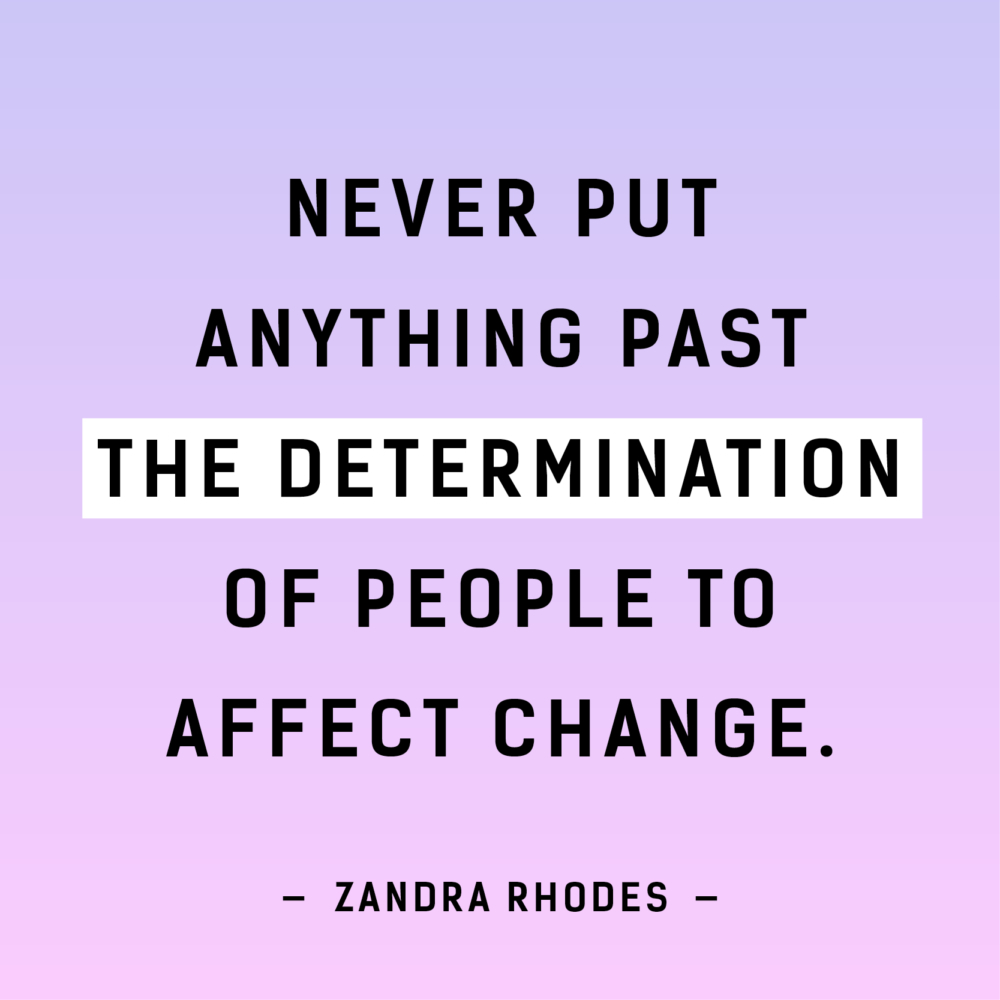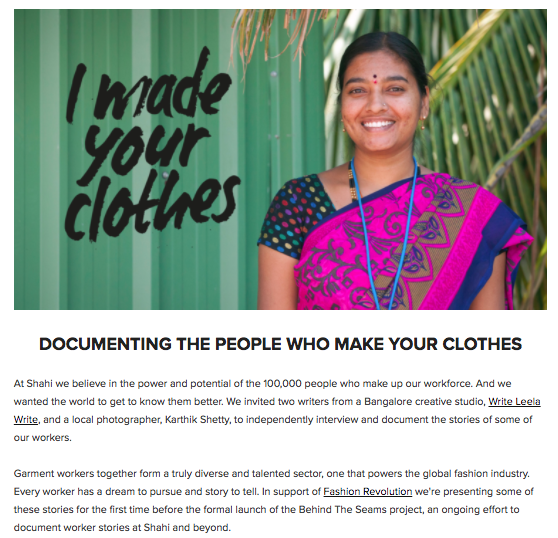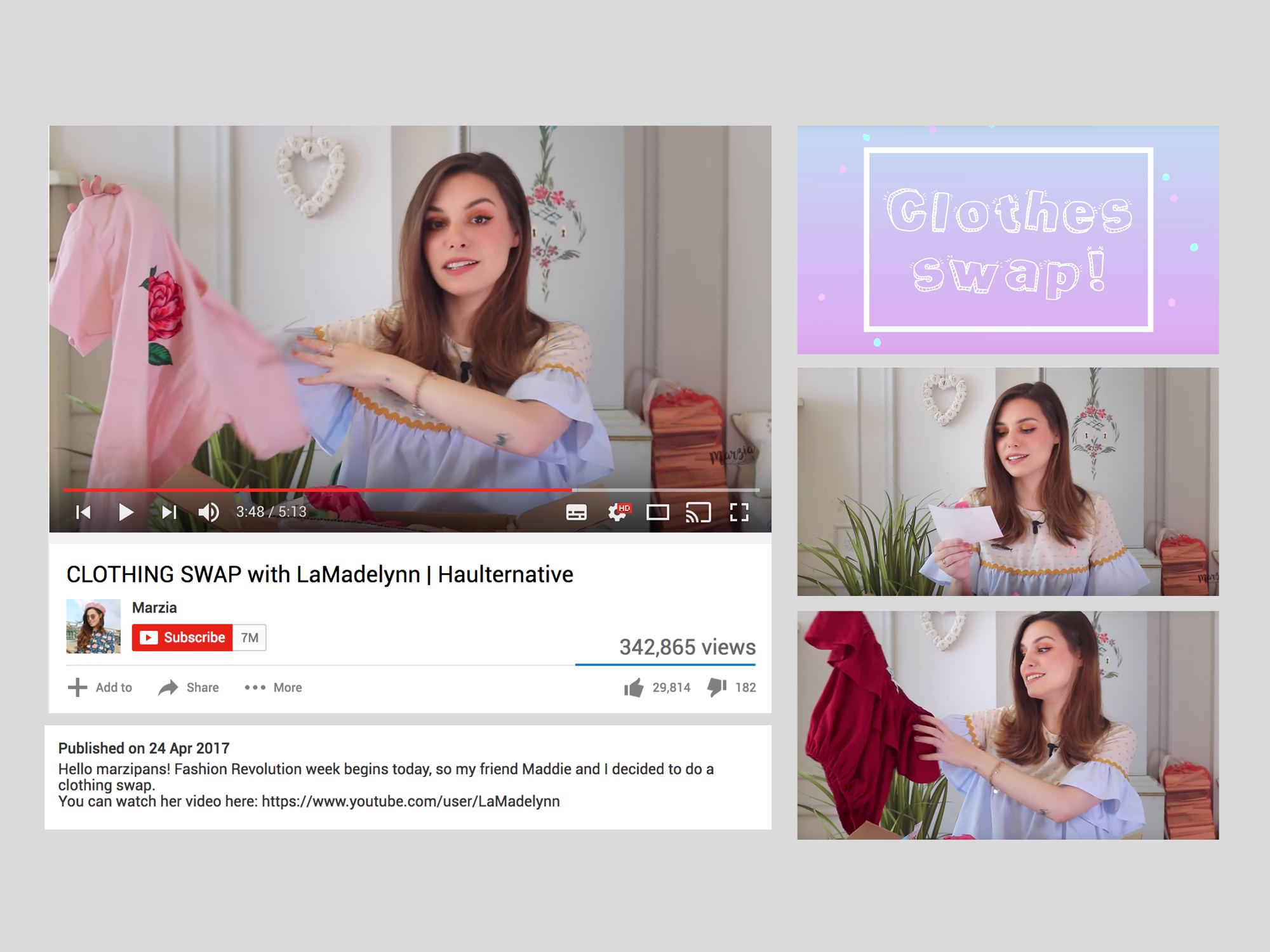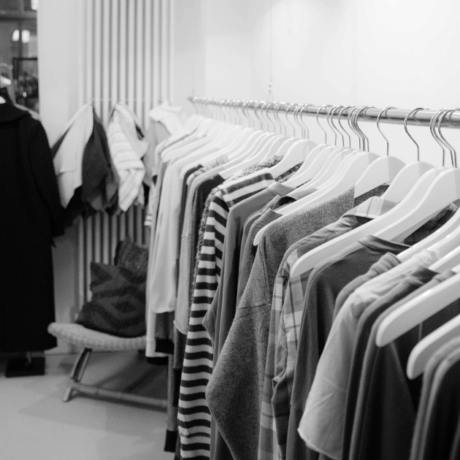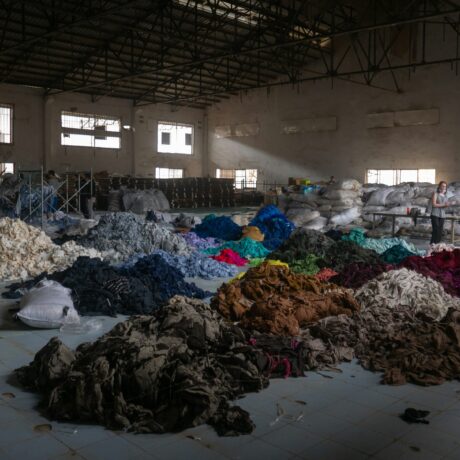Fashion Revolution Week 2017
Fashion Revolution Week 2017 was our biggest and loudest to date
Our movement continues to grow, with more people than ever calling for a fairer, safer, more transparent fashion industry.
From Australia to Brazil, Uruguay to Vietnam, we saw 2 million people engage with Fashion Revolution in April through events, posting on social media, viewing our videos or downloading resources from our website. 66,000 people attended around 1000 Fashion Revolution events, from catwalks and clothes swaps, to film screenings, panel discussions, creative stunts and workshops. A further 740 events took place in schools and universities, assisted by our network of 120 student ambassadors around the world.
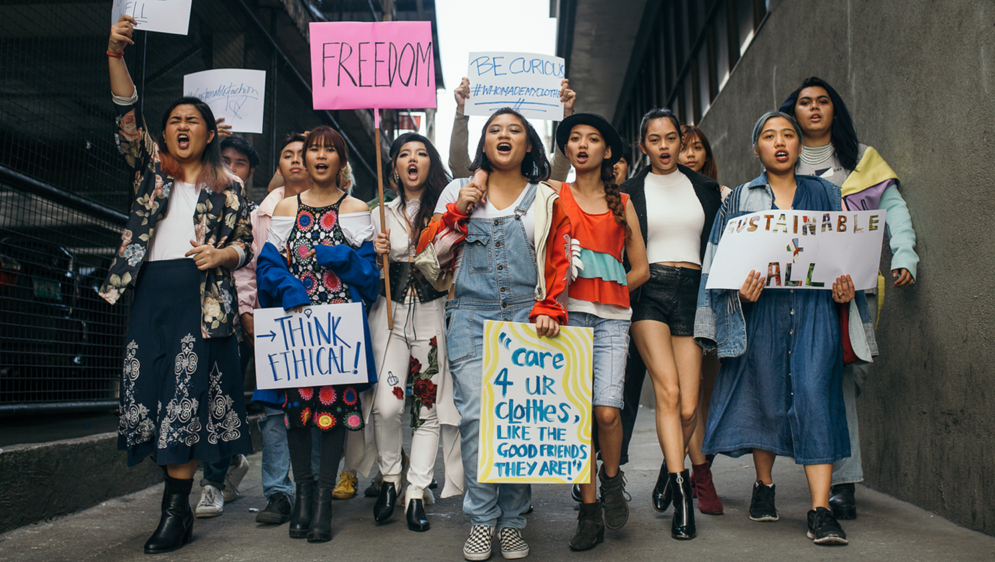
More people want to know #whomademyclothes
As in previous years, our social media impact was immense, with 533 million impressions of posts using one of our hashtags during April – an increase of almost 250% on last year.
Over the week we have been joined by hundreds of celebrities and influencers including internationally-recognised names such as actress Emma Watson, pro-surfer Kelly Slater, artist Shepard Fairey, editor-in-chief of Marie Claire Italia Antonella Antonelli, Brazilian actress Fernanda Paes Leme, Nobel Prize Winner Professor Yunus and cooks Jasmine and Melissa Hemsley, and Bangladeshi ex child worker Kalpona Akter.
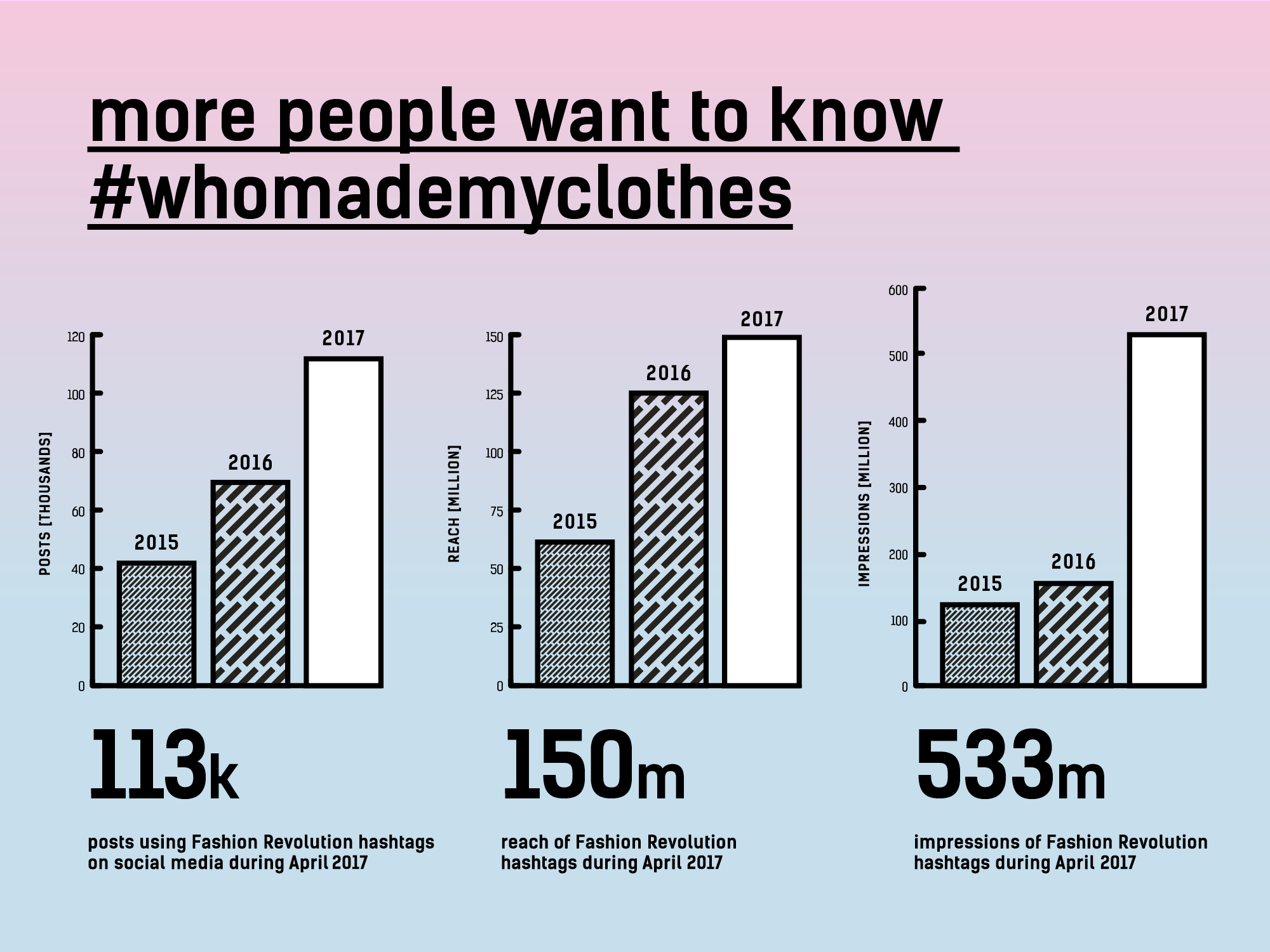
More producers are telling us #imadeyourclothes
We also saw 50% more users of our hashtag #imadeyourclothes on instagram, giving visibility to some of the millions of people who are making our clothes around the world. We are proud that Fashion Revolution Week highlights the processes and celebrates the makers behind our clothing, those who are so often invisible and marginalised.
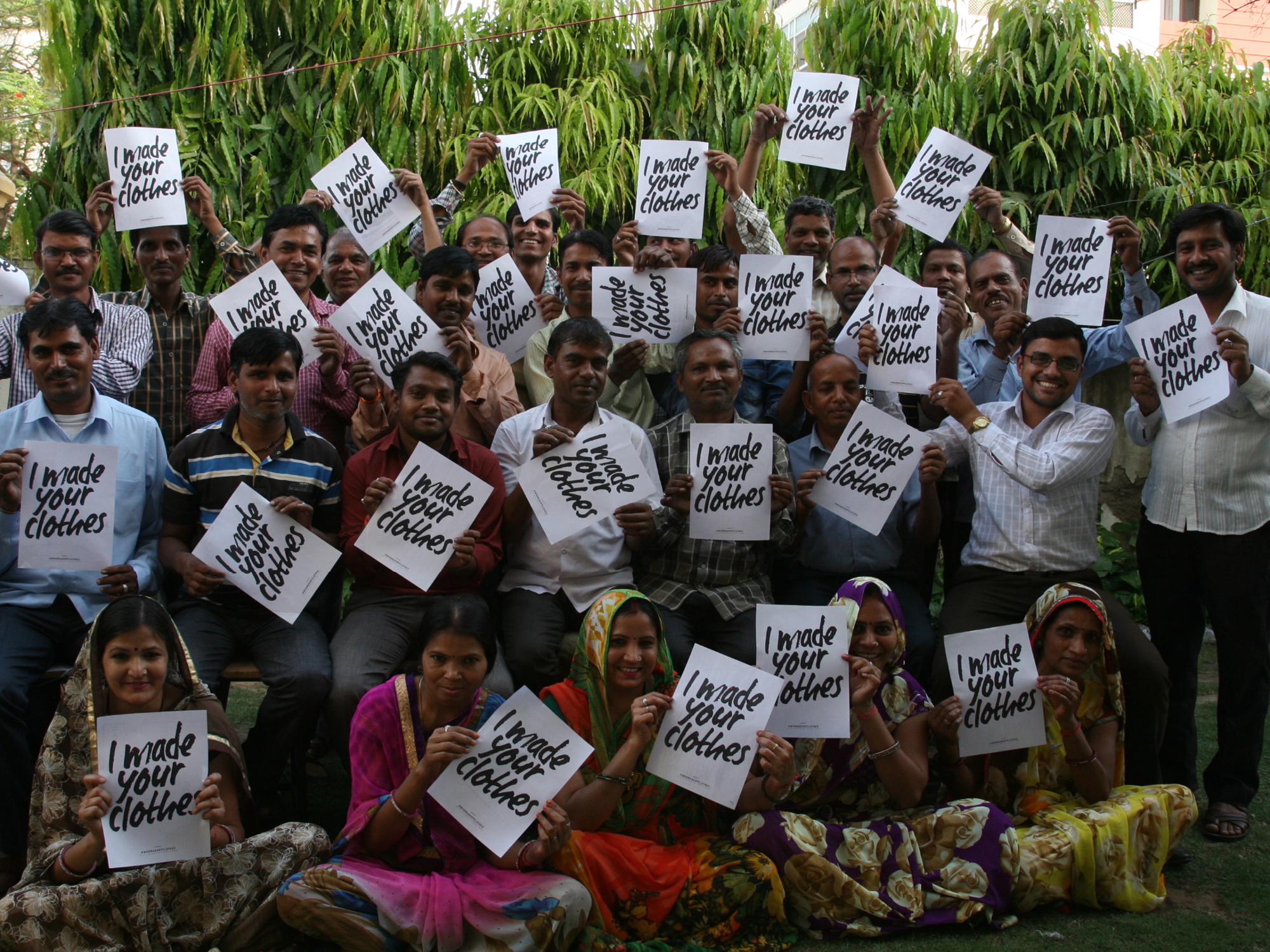
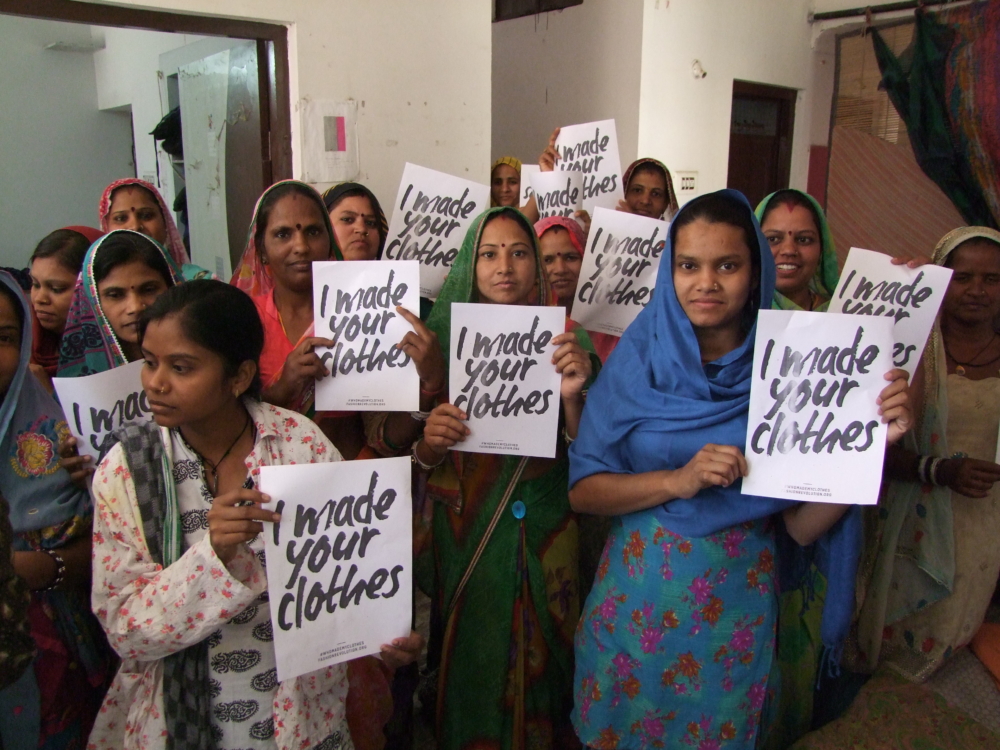
We launched our Open Studios initiative, which saw designers around the world opening up their studios, hosting workshops and talking about how they make their clothes. Curated by Tamsin Blanchard, the week-long series of events across London, New York, Athens, Prato in Italy, LA and Jakarta, featured designers who work in ways that they hope offer an alternative to the fast fashion system. Some of the designers offered workshops to teach the public how to crochet/repair/sew/hand print. Wilsen Willem in Jakarta offered a master class in shirt making. Raquel Allegra in LA gave her audience a lesson in tie-dye. In London, there was a tour of a craft jeans atelier Blackhorse Lane Ateliers as well a tote bag making session with Christopher Raeburn using his waste fabric remnants and Fashion Revolution patches from Avery Dennison. The Open Studios initiative helped engage people in conversations about how clothes are made, the intricacies of the supply and manufacturing process, and begin to understand issues around supply chains, carbon footprint, and waste.
More brands are responding
We have again seen a number of fashion brands getting involved and answering, or attempting to answer, their customers’ #whomademyclothes questions. Global brands such as Zara, Fat Face, Massimo Dutti, Pull and Bear, G Star Raw, Marks and Spencer, Marimekko and Gildan are among more than 2000 fashion brands and retailers that responded with real information about their suppliers or photographs of their workers saying #imadeyourclothes, almost double the number who responded last year.
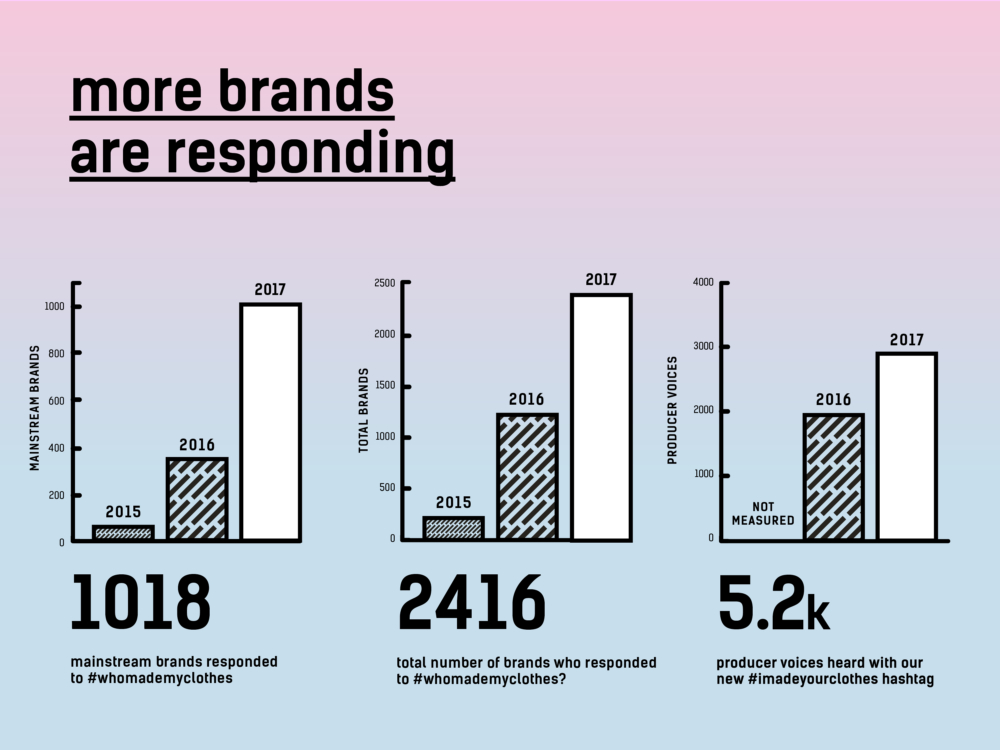
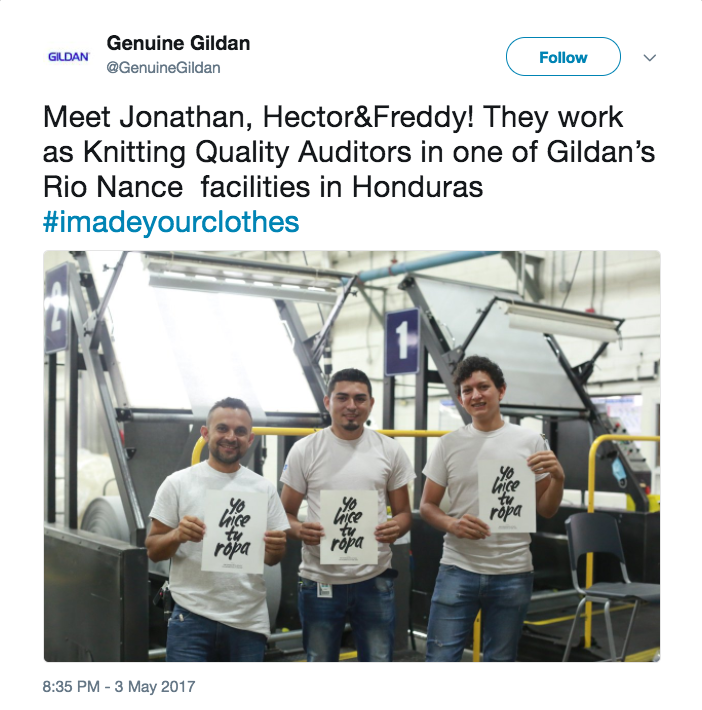
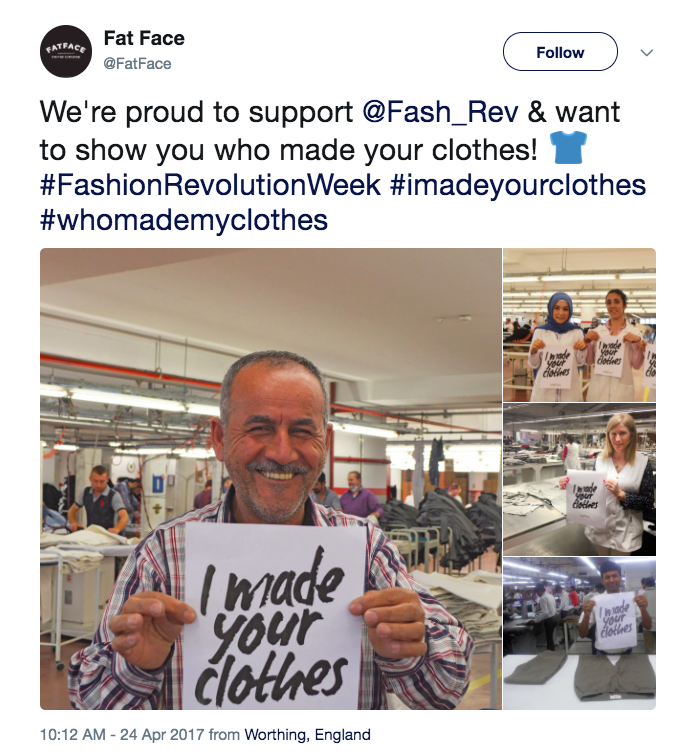
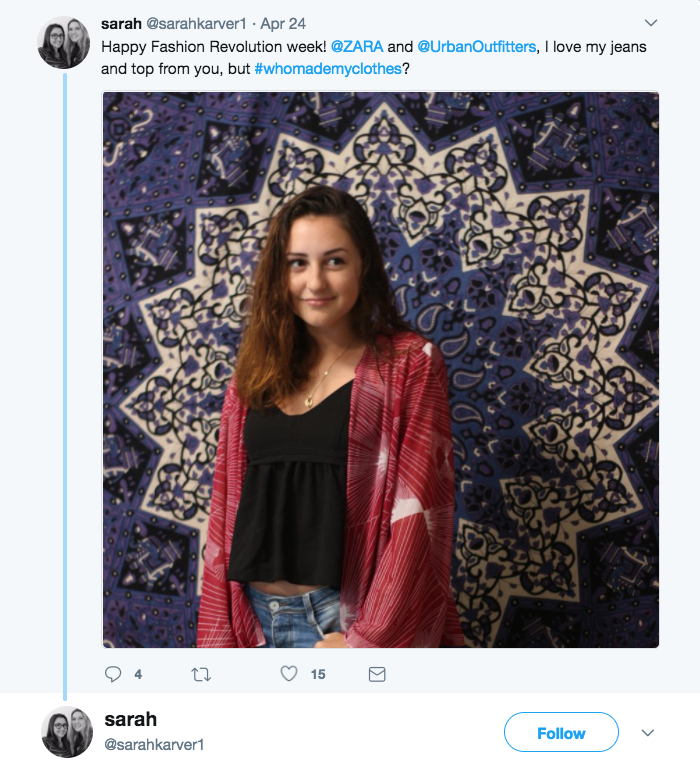
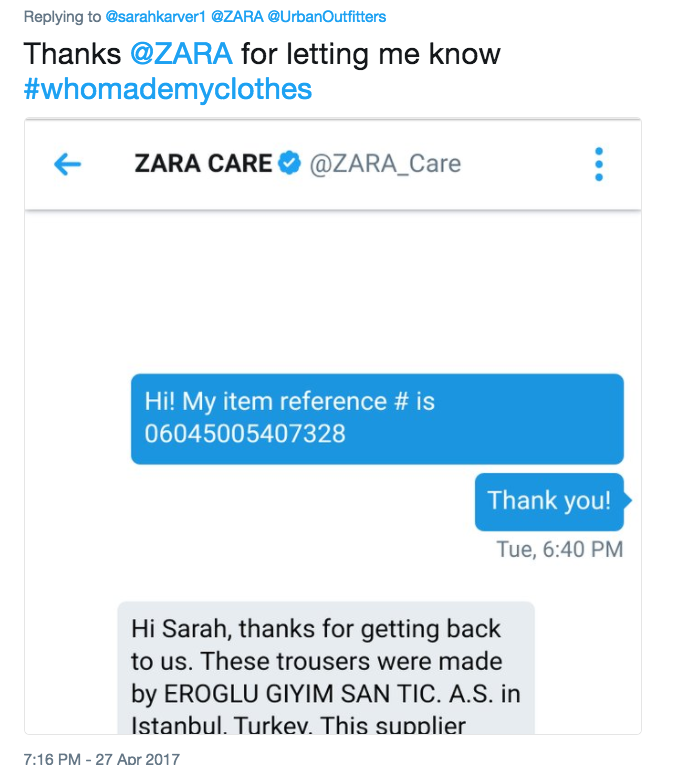
India’s largest ready made garment exporter, Shahi, built a website specifically for Fashion Revolution Week to tell the stories of some of the 100,000 people who make their clothes.
There’s still a long way to go
But thousands of #whomademyclothes questions remained unanswered by fashion brands. In July, Fashion Revolution MOOC participants asked, asked again, recorded brand responses and did their own investigations. Read more in the blog What can you do when customer helplines aren’t very helpful? and in this fascinating Storify post listing brands responses to #whomademyclothes, helpful and otherwise.
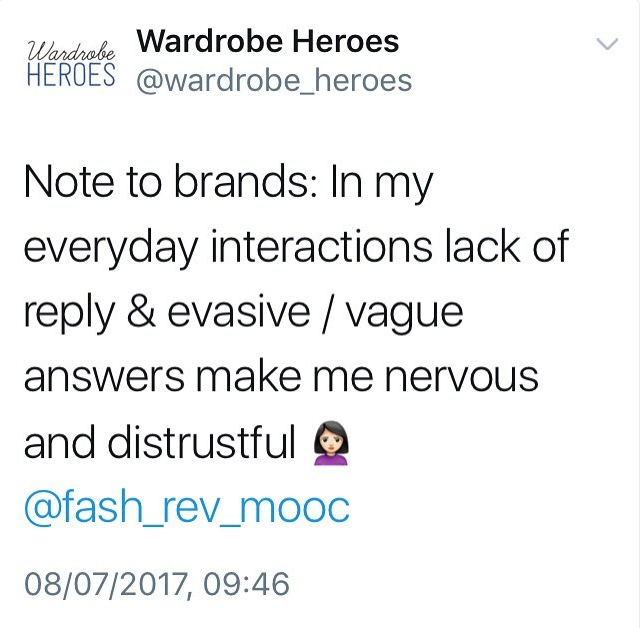
Our collective voice is powerful
By asking the simple question #whomademyclothes to brands, we have ignited a global conversation about supply chain transparency, and started to inspire people to think differently about what they wear.
As we’ve seen over the last few years, the more people who ask #whomademyclothes the more brands will listen. Our questions, our voices, and our shopping habits have the power to help change the industry for the better, and together we are stronger.
The world was listening
There was significant global media coverage about transparency in the fashion industry and ways to consume more responsibly, with over 12 billion reach of articles about Fashion Revolution in April. Significant articles included Forbes, German, Italian, Indian and British Vogue, L’Express, El País, The Hindu, MSN, Fashionista, The Telegraph, The Guardian, The Independent, Huffington Post, Marie Claire, Elle Japan, Harpers Bazaar, Refinery 29, The Debrief and many more. Fashion Revolution made their debut at Cape Town Fashion Week, covered by Glamour magazine amongst others. Carry Somers, co-founder and Global Operations Director, spoke to BBC World News and Sarah Ditty, Head of Policy, spoke to Reuters about the Fashion Transparency Index.
Transparency: some progress, but more still needs to be done
Our 2017 Fashion Transparency Index, published on 24 April, revealed that many of the biggest fashion brands still don’t disclose enough information about their impact on the lives of workers in their supply chain and on the environment. We are seeing brands begin to publish more about their social and environmental efforts, which is welcome and necessary, and we are seeing an increasing number of brands publishing their factory lists. As of June 2017, we have counted 106 brands across 42 companies/parent groups that are disclosing at least some of the facilities making their clothes. See our post Transparency is Trending for more information and a brand list.
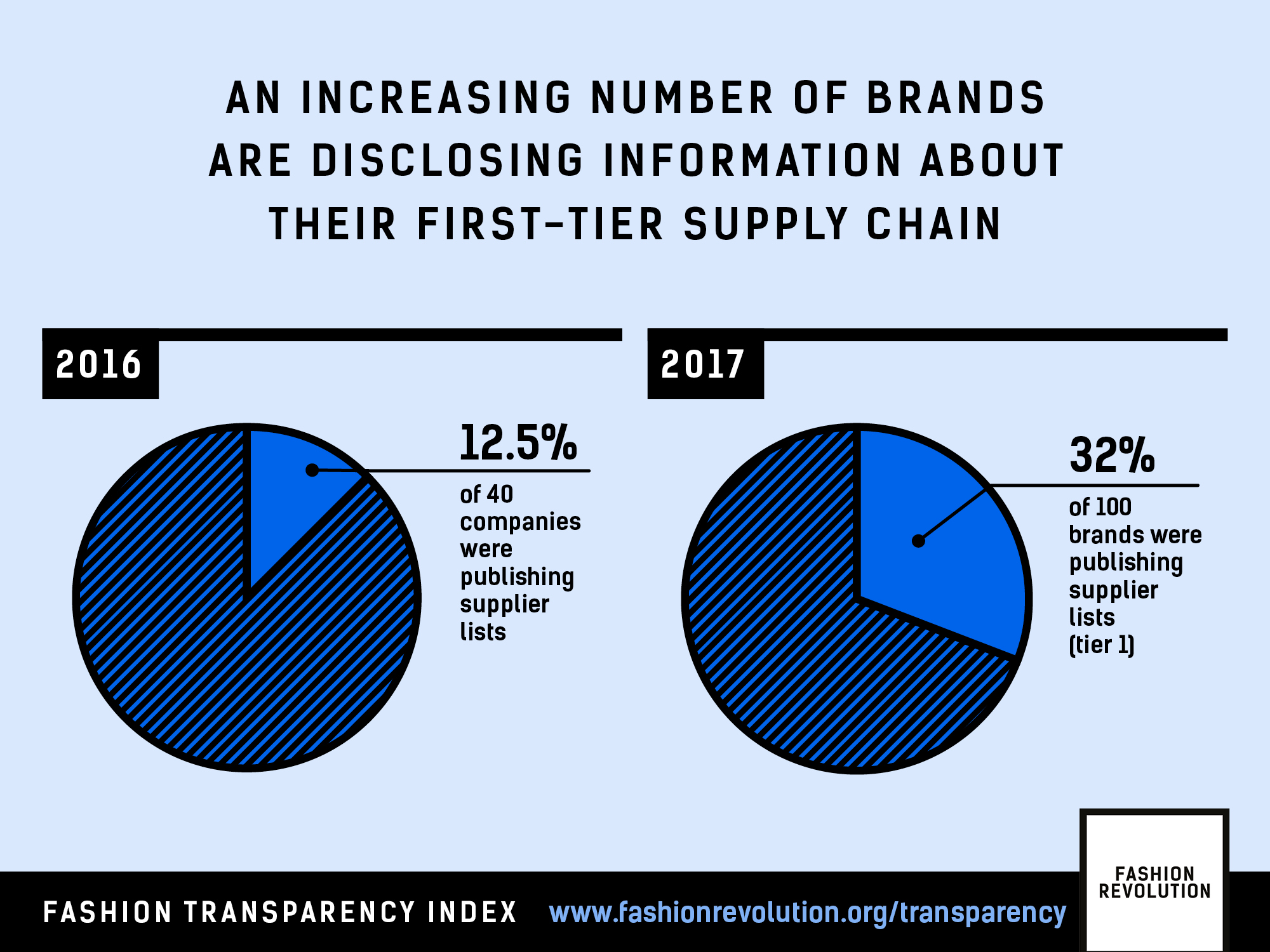
However, our research found that even the highest scoring brands on the list still have a long way to go towards being transparent. The average score brands achieved was 49 out of 250, less than 20% of the total possible points, and none of the companies on the list scored above 50%. Although more brands are reporting on their policies and commitments, very few are disclosing what impacts their supply chain efforts are having towards improving conditions for workers. This means the public has virtually no way of knowing if brands’ policies and procedures are truly effective and driving improvements for the people making our clothes. By publishing the Fashion Transparency Index, we hope brands will be pushed in a more positive direction towards a fundamental shift in the way the system works, beginning with being more transparent.
Loved Clothes Last
In the Fashion Transparency Index, while a few brands are reporting initiatives to collect, recycle or donate used clothing, overall brands do not disclose many substantive efforts to address the problem of overconsumption. Fashion Revolution has been working to educate consumers on the impact of their clothing purchases and ways in which they can fill their wardrobes in a more responsible way.
From some of the world’s most famous YouTubers to first-time vloggers, the #haulternative project continues to grow. The clothes swap between CutiePieMarzia and La Madelynn has been viewed almost 700,000 times to date and Kristen Leo’s Thrift Store haul has been viewed by 100,000 people. Over 90 people made their own #haulternative videos, up 44% from last year, sharing ways to update your wardrobe without buying new.
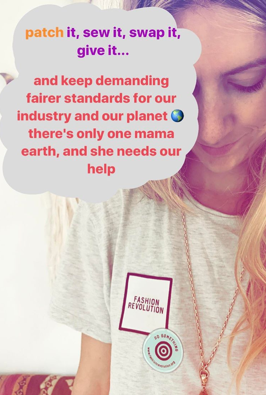
Avery Dennison partnered with Fashion Revolution to create some branded patches (made with up to 90% recycled yarns) to encourage people to mend their much loved but broken garments and give them a new lease of life, as well as a series of ‘hack’ films as part of the #haulternative project. The three 1-minute films presented tutorials including how to sew on a patch, how to make a pom-pom and how to embroider a flower garden.
YouTuber Cutie Pie Marzia said “Fashion Revolution brought up topics I was never aware of and pushed me to learn more about the fashion industry. It truly changed my mindset, and I am truly grateful for that, because now I can make better choices while sharing the things I’ve come to know with lots of people. I am positive that, all together, we can make a difference”.
We collaborated with AEG/Electrolux on the Loved Clothes Last project and launched a video looking at mass production, consumerism and the tragedy of modern-day landfills, to remind us that small individual actions can have a lasting effect. We have also been working with Greenpeace to highlight some of the most shocking statistics around consumption and waste.
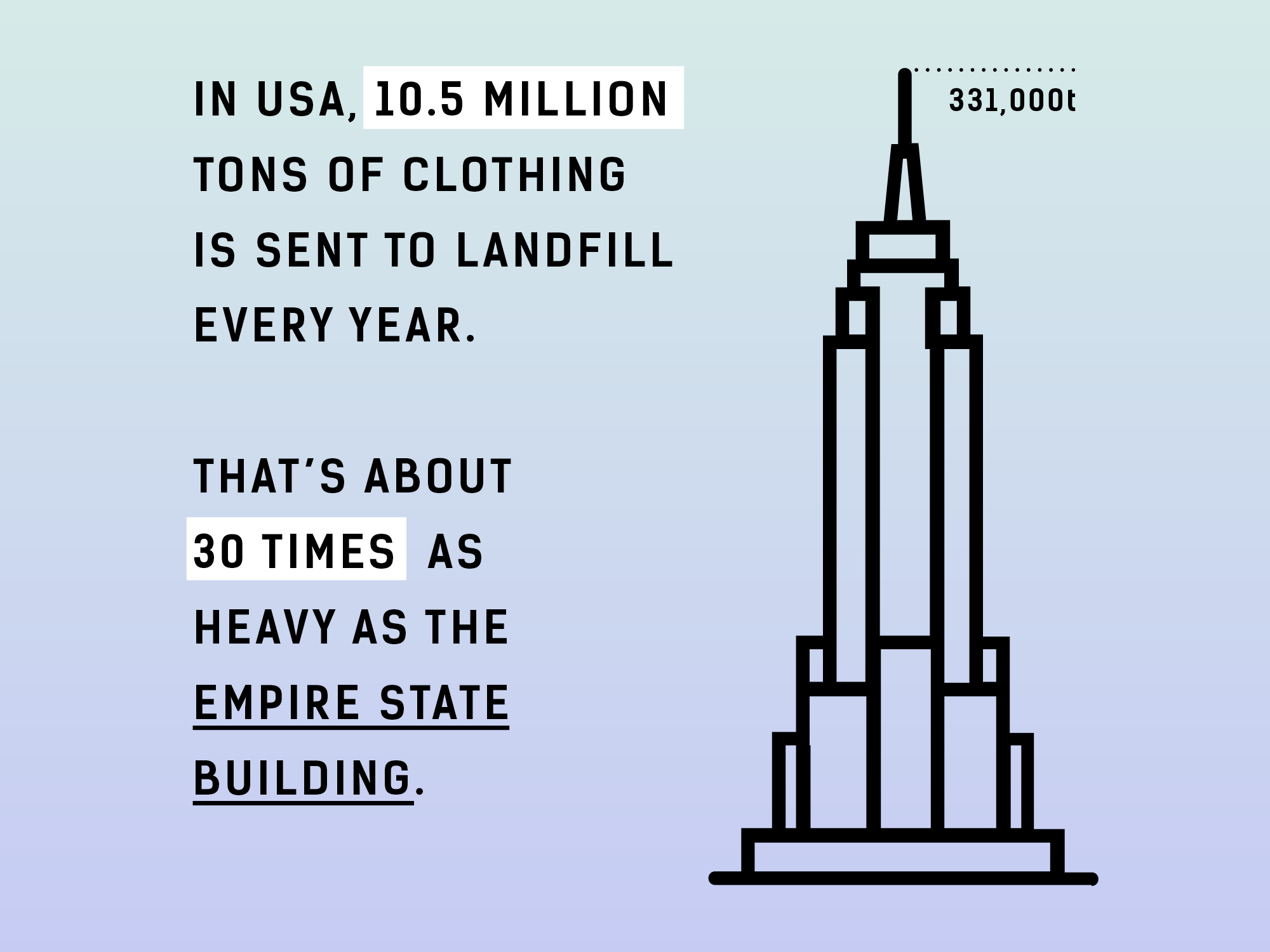
More Than a Hashtag
Fashion Revolution is far more than just a week-long annual hashtag campaign. We work year-round on research and communications to raise awareness of the myriad issues which need addressing within the fashion industry.
This summer we’ve beeen working on our next fanzine (launching October 2017), creating some podcasts, and planning the third-edition of our Fashion Transparency Index, which will look at even more brands!
One of our main projects this year has been the Garment Worker Diaries. Led by Microfinance and supported by C&A Foundation, on-the-ground research partners are meeting with 540 garment workers in India, Cambodia and Bangladesh on a weekly basis for an entire year to learn the intimate details of their lives, asking what they earn and buy, how they spend their time each day and whether they experience any harassment, injuries, or suffer from pain while at the factory. The key insights from this project will be launched later this summer.
Taslima Akhter is the photographer who captured the haunting photograph ‘The Final Embrace’ at the the Rana Plaza factory collapse. Taslima also took other photographs in the aftermath of the Rana Plaza collapse, talking to those rescued and injured, and the families of people who had died. Four years on, we commissioned her to return to meet some of those people again to find out how their lives have changed. You can read the stories of Rupaly, Alam and Asma in our blog post Rana Plaza: The Survivors’ Stories.
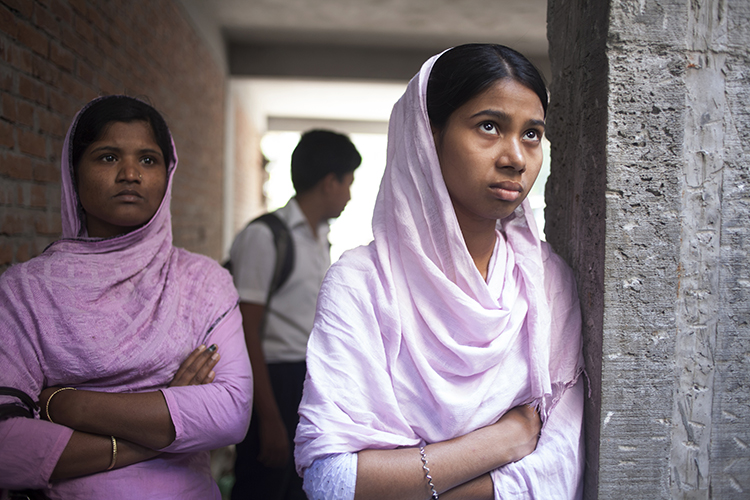
We continue to work with policymakers around the world to look at ways governments can support more transparency from the fashion industry. This year, 89 political influencers, government officials or policy makers have publicly shown their support for Fashion Revolution, with our teams organising or speaking at 80 events around policy issues. These included the OECD Roundtable in Paris on Garment Supply Chain Due Diligence; Fashion Question Time in UK Houses of Parliament; a high-level meeting in the European Parliament ‘Remembering Rana Plaza – how can we create fair and sustainable supply chains in the garment sector?’; meeting with the Minister of Economic Development and General Secretary of clothing and textile workers union in South Africa; meeting between the Malaysian coordinator and the UN to discuss growing ethical fashion in Asia Pacific and a meeting with the Vice President of Cambodia’s largest garment worker union, the Free Trade Union for the Workers of the Kingdom of Cambodia.
Thank you!
Thank you to all of you who took part. It is because of your voice, persistence and continued support that we have grown to become the biggest fashion advocacy movement on the planet. We are stronger when we speak and work together. Thank you so much! Please keep walking alongside us on the journey towards a fairer, cleaner, safer and more beautiful fashion industry.
Help us grow our movement to inspire more people to think differently about the clothes they buy and wear, by donating. Even the smallest donation will help us to continue delivering the resources we need to run our revolution. Use your money and your voice to transform the fashion industry into a force for good.
You are Fashion Revolution and you are changing the fashion industry. Please keep asking #whomademyclothes.
